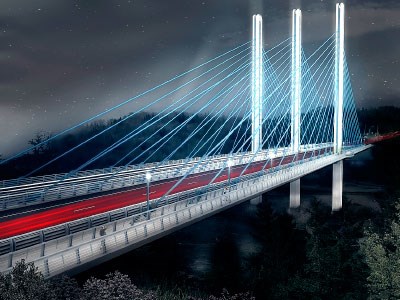It’s one of the most technically challenging — and dramatic — bridges ever built in Ontario.
The Nipigon River Bridge, now being built just outside of the northwestern Ontario town of Nipigon, is part of a larger project to twin the Trans-Canada Highway between Nipigon and Thunder Bay. Part of what makes the project so complex is its location. The rocky terrain of the Canadian Shield, the irregular river banks near the mouth to Lake Superior, the need to maintain traffic over the river, and the delicate environmental ecosystem around it all led to creative solutions using the latest technologies.
“This project had to be built in a very narrow corridor with the (trout) spawning beds just north of the bridge and a CPR railway structure directly south,” said Annemarie Piscopo, northwestern region communications co-ordinator for the Ontario Ministry of Transportation.
Previous work, years ago, showed how disturbing the waters could seriously impact trout population. For that reason, the bridge could not have footings within the river itself.
“The environmental challenges at this location were part of the constraints that facilitated the need for a long span structure. A number of bridge structures and types were reviewed during the design phase of the project,” Piscopo said.
The solution was to build a cable-stayed bridge — the first such bridge in Ontario — which uses towers to hold up the bridge deck with a series of cables, similar to a suspension bridge. The advantage of this design at the Nipigon River is that it allows a fairly lengthy span to be supported by just one set of towers built on dry land, not in the river itself.
When completed, the bridge will span 252 metres. The three-tower centre pier rises 51 metres above the bridge deck, which is supported by 66 steel cables anchored to the towers. A pedestrian pathway separated from traffic will allow people to safely walk across the river.
The construction itself incorporated some of the latest bridge-building materials including glass fibre-reinforced polymers (GFRP) to make it lighter and less susceptible to corrosion. Further, the latest building techniques are helping make the build more efficient.
“The upper components of the towers and the bridge deck are all built using pre-cast concrete technology,” Piscopo said. “This ensures a high level of quality while shortening the onsite construction time from conventional cast-in-place concrete. The pre-cast concrete deck panels are being joined together using a product called ‘Ductal’, an innovative ultra-high performance concrete developed by Lafarge.”
This allows bridges to have longer, thinner spans. Not only does this make the bridge load lighter, Ductal increases overall durability of the bridge while its slighter profile allows designers to create more aesthetically pleasing structures. Other advantages include faster construction time and lower overall costs.
The project is a joint venture between Bot Construction and international construction company Ferrovial Agroman (Bot Ferrovial Nipigon Joint Venture), with the ministry as project owner. Building the new bridge also involved consulting residents of Nipigon and the Red Rock Indian Band.
“During design and now in construction, we have continued to maintain good communications with both the Red Rock Indian Band and the Town of Nipigon,” Piscopo said.
“Understanding the concerns of the communities and facilitating a communication channel with the ministry and the contractor has helped us mitigate any concerns that the communities have had. This has also allowed both communities an opportunity to showcase the local services that they can provide to the contractor on this bridge construction project.”
The project is on track to be completed and open to all four lanes of traffic by 2017, Piscopo said.




